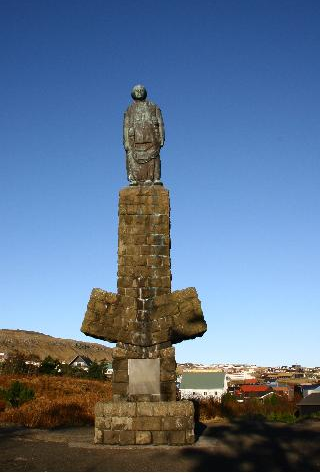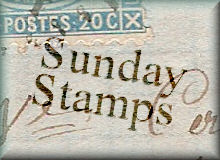The Faroe's flag was first flown officially in war. When Denmark was occupied in April 1940 British troops had to act quickly to ensure the islands in a strategically important area (at the time under Danish control) were not occupied by the Germans. British troops landed on the islands in April 1940 in an operation codenamed 'Operation Valentine'. As it turned out this was a prophetic name because one of the results of what has been called "the friendly invasion" was ultimately lots of marriages between local Faroese girls and British soldiers. A figure of 170 has been quoted.
The flag shown on the stamp was devised by Jens Oliver Lisberg with two other Faroese students while studying in Copenhagen in 1919 and was first raised for a wedding in June of that year. By the 1930s it was in common, but unofficial, use. With the events of 1940 the British government approved and recognised the flag for use by Faroese vessels to distinguish them as friendly ships.
The Faroes sailors provided vital food for Britain during the war and they fed Britain by sailing for fish. This was at a cost for the waters around the Faroe islands were patrolled by German U Boats and drifting sea mines were a considerable problem. The two ships shown on the mini sheet both were lost.
On the left is the trawler 'Nyggjaberg' torpedoed and sunk on the 28 March 1942 near Iceland and the worst single loss of Faroese life with 21 seamen. The sailing ship is the schooner 'Sanna' sunk by a German aeroplane in 1942 north of the Faroes with a loss of 8 lives. In all 210 Faroe sailors lost their life at sea and a monument was erected to them at Tórshavn in 1956.
After the war the Home Rule Act of 23 March 1946 was passed by the Danish parliament and the flag was now official, but the Faroe Islanders celebrate Flaggdagur on the original day it was first flown and recognised by another country, 25 April, a national holiday. Its creator did not live to see the occasion for he had died in 1920 of pneumonia and is buried at Fámjin where the church displays the original copy of the flag or Merkið , which means 'the banner' or 'the mark'. The white symbolises the pure sky and the foam of waves breaking against the island and the red and blue are colours found on other Nordic nation's crosses.
An entry to Viridian Postcard's Sunday Stamps theme inspired by Memorial Day.
Stamps commemorating a person or event worth remembering here.




10 comments:
more lessons in history, and about one of the more exotic regions in europe...the sheet is simple yet eye-catching
the sheet is fantastic...and i love the outcome of Operation Valentine :)
I'm learning a lot this week. iknew of the Faroese flag but not the story behind it. Great sheet.
"The Postal Picture" has been included in the A Sunday Drive for this week. Be assured that I hope this helps to point even more new visitors in your direction.
http://asthecrackerheadcrumbles.blogspot.com/2014/05/a-sunday-drive_25.html
This is a piece of history new to me. It's a fascinating story. I love the colour scheme of the stamps which seems to me very much of that era.
I like the design of the sheet and found the history interesting.
I like the design of these stamps. I must admit, I've never really thought about the designers of those flags with a cross, or stripes on them.
Very pretty sheet of stamps. So colorful, love them.
The stamps are really well-designed, a piece of Nordic style. I didn't know about the story behind, so thank you.
Thank you for sharing this story. ANd thank you for joining in this week.
Post a Comment